Live
- All you need to know about PAN 2.0
- Akasa Air redefines travel experience with industry-first offerings
- MP: Residents stage protests against liquor shop in Indore
- Telugu Actor Shri Tej Booked for Alleged Cheating and False Promise of Marriage in Live-in Relationship
- Toyota Kirloskar Motor Celebrates 1 Lakh Urban Cruiser Hyryder on Indian Road
- MLS: New York City FC part ways with head coach Nick Cushing
- Delhi CM says Centre cutting AAP voters’ names from rolls, BJP hits back
- Hyderabad Metro Rail Phase-II Works to Begin in Old City in January 2025
- Odisha: 668 persons killed in human-elephant conflicts in last three years
- DEFENDER JOURNEYS: TO EMBARK ON ITS THIRD EDITION FROM NOVEMBER 2024
Just In

In one of the worst rail disasters in the country, 120 persons were killed and over 100 injured before dawn on Sunday when 14 coaches of the Indore-Patna Express derailed near Kanpur.
Deadly train derailment kills 120 in UP
Kanpur : In one of the worst rail disasters in the country, 120 persons were killed and over 100 injured before dawn on Sunday when 14 coaches of the Indore-Patna Express derailed near Kanpur. The tragedy occurred when the Patna-bound train's coaches ran off the rails shortly after 3 am near Pukhrayan station, about 60 km from Kanpur city in Uttar Pradesh, railway and police officials said.
Inspector General of Police Prabhakar Chowdhary said that 116 had died and 49 still warded in different hospitals had been shifted to Kanpur. All others have been given first aid and discharged. The deaths could rise as some passengers were in critical condition.
Panic set in when the coaches derailed in darkness, throwing scores of sleeping passengers over one another. Many took a while to realise that a tragedy had hit the train. Passengers who survived related that there was screaming and shouting as many of the injured were in agony. The worst-hit were the sleeper coaches S1, S2, S3 and S4.
A passenger who survived said that the train stopped a couple of moments after 3 am for unexplained reasons. "It then suddenly picked up speed," the man said. "And then I got an eerie feeling that the train was rolling down a valley," he said.
"By the time I leant what had happened, some 20-25 people in my coach had been killed. A six-year-old girl was literally cut into two pieces," said the terrified man. Swayambi Mishra, in her early 20s, said she was in S1 and she did not know what had happened to her father.
A passenger in his 60s added: "God saved me. But most of the people who were with me in the coach seem to have disappeared. I can't find them." It was the worst train accident in the country after the May 2010 disaster in West Bengal involving Gyaneshwari Express that killed some 170 people.
Relief officials described gory scenes, with many passengers crushed by tonnes of steel as some coaches rolled over. Gas cutters were used to rip through the coaches to take out the bodies and the wounded. Hundreds of bags and suitcases belonging to the passengers were strewn all along the rail track.
National Disaster Response Force (NDRF) spokesperson Krishna Kumar told IANS: "Most bodies are beyond recognition as they are badly crushed." Said another dazed survivor: "I was awake when the train derailed. There was a loud noise and then pandemonium broke out. I thought I was dreaming. My wife and children are fortunately safe..."
Survivors said the first to reach the semi-rural site were villagers. An Uttar Pradesh constable rescued five people from S1 coach. "I felt bad...I had to walk over some bodies but I had no choice as I had to save those who were alive." A row erupted when Minister of State for Railways Manoj Sinha visited a hospital in Kanpur and gave an injured woman Rs 5,000 in demonetised notes of Rs 500.
Railway Minister Suresh Prabhu and the governments of Uttar Pradesh and Madhya Pradesh also announced financial compensation. The railways used heavy machinery to separate the tangled coaches. NDRF personnel used hammers to smash the windowpanes to enter the air-conditioned coaches as most doors were locked from inside.
A railway official in Indore said the train, which left on Saturday and would have reached Patna on Sunday evening, was carrying 1,266 passengers, including 308 in air-conditioned coaches.
Minister Prabhu ordered an inquiry and vowed to take "strictest possible action" against the guilty. Kanpur MP and senior BJP leader Murli Manohar Joshi suspected foul play. Later, a special train left from the accident site for Patna with the passengers who survived the disaster and could travel.
In the hospitals, the wounded remained, frightened by what had happened. Some families got separated as relief officials, unknowingly, rushed a few from a family to one hospital and others to another.

© 2024 Hyderabad Media House Limited/The Hans India. All rights reserved. Powered by hocalwire.com







